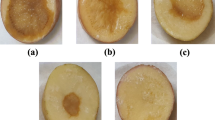Summary
The antagonistic microflora in the rhizosphere of plants of three varieties of potato, viz. Ps 194' ‘Up to date’, and a local variety of different ages were analysed. Antagonists were selected either by random isolation or by Wilska's spraying technique. The antagonists were always found in higher frequency in rhizosphere compared with the control soil. The highest percentage of actinomycetes antagonists were found in the variety Up to date; of fungal antagonists in the variety Ps 194; while the local variety was found to be the poorest in this regard. Further, the antagonistic activity of these organisms was estimated by a cross-streak method and the resistant antagonists were also selected by cross-antagonism. The most resistant antagonists found were Trichoderma viride T 56 and T 7, Chaetomium trilaterate F 75, Streptomyces alboflavus Rs 40, Streptomyces sp. Cs 73, Pseudomonas sp. Rs 1 50 and Pseudomonas sp III Ps 63.
Similar content being viewed by others
References
Agnihothrudu, V., Soil conditions and wilt disease in plants, rhizosphere microflora in relation to fungal wilt. Ph.D. thesis. Madras Univ. Madras India (1956).
Chan, E. C. S. and Katznelson, H., Growth interactions of Arthrobacter globiformis and Pseudomonas sp. in relation to rhizosphere effect. Can. J. Microbiol. 7, 759–767 (1961).
Katznelson, H., Nature and importance of rhizosphere. In Ecology of Soil-borne Pathogens, Ed. Kenneth, F. and Baker et al. California Univ. 187–209 (1965).
Mall, S. and Saksena, S. B., Antagonistic studies in rhizosphere microflora of potato with special reference to varietal resistance. (Abstract). Proc. Ind. Sci. Congr. (1971).'
Rhem, H. I., Beitrag zur Okologie der Streptomyceten. 3. Die Streptomycetenarten und ihre antibiotische Activitat in der Rhizosphare der Gerste. Z. Bakteriol. Parasitenk. Abt. II 114, 147–155 (1961).
Shrivastava, S. and Saksena, S. B., Studies on rhizosphere microflora of potato with special reference to black-scurf and wilt disease. Indian Phytopathol. Sec. Bull. 4, 107–119 (1968).
Shrivastava, S., Fusarium wilt of potato in India. I. Occurrence and pathogenicity. Indian Phytopathol. 23, 503–510 (1970).
Strzelczyk, E., Studies on the interaction of plants and free living nitrogen fixing micro-organisms. II. Development of antagonists of Azotobacter in the rhizosphere of plants at different stages of growth in two soils. Can. J. Microbiol. 7, 507–513 (1961).
Strzelczykowa, A. and Strzelczyk, E., The influence of antagonistic actinomycetes on some soil bacteria. Acta. Microbiol. Polon. 7, 283–297 (1968).
Venkatesan, R., Studies on actinomycetes of paddy soils. Ph.D. thesis. Annamalai Univ. Annamalai India (1962).
Wilska, A., Spray inoculation of plates in the detection of antagonistic microorganisms. J. Gen. Microbiol. 1, 368–369 (1947).
Author information
Authors and Affiliations
Rights and permissions
About this article
Cite this article
Mall, S. Studies on microbial antagonism in rhizosphere soils of potato varieties differentially susceptible to black-scurf and wilt. Plant Soil 39, 547–554 (1973). https://doi.org/10.1007/BF00264172
Received:
Revised:
Issue Date:
DOI: https://doi.org/10.1007/BF00264172




